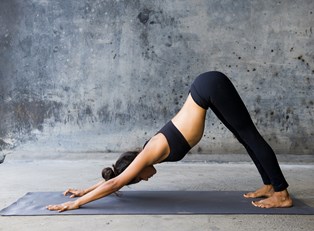History
Vinyasa Yoga was created by Parrabhi Jois who had first studied Ashtanga Vinyasa Yoga with his yoga instructor, Sri Tirumala Krishnamacharya. Both forms are derived from traditional Hatha Yoga, which strives to make a connection between the body and mind. Joi was particularly interested in the power of breathing as it connected to the postures, or asanas. His passion for the connection of movement and breath resulted in the specific yoga of Vinyasa Yoga.
Vinyasa has many meanings, but generally can be defined as breath-synchronized movement. Other definitions are based on the idea of connection. Vinyasa yoga is characterized by flowing movements that are connected through breath.
Basic Principles
The basic principle of Vinyasa Yoga is a flowing series of movements, or asanas. Some might even describe these as being dance-like. Controlled breathing is another important component. In fact, the instructor will ask you to move from one pose to another as you inhale or exhale. Typically upward movements are timed with inhalations and downward movements are timed with exhalations.
One of the benefits of Vinyasa Yoga is increased cardiovascular strength. Cardiovascular benefits occur because of the flowing, dance-like movements that are not present in more traditional yoga forms. Additionally, extended practice of Vinyasa Yoga can reduce stress levels while increasing flexibility, endurance and muscle strength.
Vinyasa Yoga classes offer great diversity. While some types of yoga, like Bikram Yoga, contain a scripted set of poses, Vinyasa instructors have the freedom to create their own dynamic. This results in significantly different classes. Because of this opportunity for diversity, you may find one class that you greatly enjoy, while another class may not suit your needs.
Poses
Regardless of the instructor, there are several poses that most Vinyasa Yoga classes will incorporate. The first is the sun salutation. This begins with the mountain pose, moves into the raised hand pose, then the standing forward bend, and ends with the downward facing dog. Instructors will often use this series of connected asanas to begin a Vinyasa Yoga class. The sun salutation series is a flowing meditation to honor both the sun and the life force within the body. The series of connected asanas also works to increase circulation while taking your body through a full range of motions.
Another basic Vinyasa Yoga movement is the cat-cow stretch. In this series, the cat pose is linked to the cow pose. You begin on your hands and knees. On an inhalation, the back is arched up toward the sky and the head falls down toward the floor, which is the cat pose. Then, on an exhalation, the head comes up and stomach is pressed down toward the floor, which creates the cow pose. This series of asanas should move from pose to pose coordinated with each breath. Benefits include strengthening and stretching the spine, neck, hips and abdomen; it also creates emotional balance.
The final series of asanas worth mentioning is the vinyasa. Vinyasa can be used as a noun to describe a series of 3 asanas. This refers to the plank, chaturanga and upward facing dog poses. Instructors often link a vinyasa to a sun salutation.
Who This is For
Vinyasa Yoga is great for anyone looking for a flowing style of yoga. You should be accustomed to moderate exercise and movement. The dance-like movements offer cardiovascular benefits along with the traditional mind-body connection.
Vinyasa Yoga is often recommended for beginners because of the engaging style. However, it is also challenging enough so that people can continue learning as they progress in perfecting the asanas. Because this style offers so much flexibility to the instructors, the style and series of movements can vary greatly. It is important to find a class and an instructor that fits your needs.


